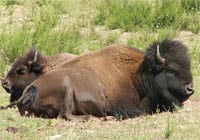25,000 Pounds of Bison Heads Recalled
By now, most of us have pretty much forgotten what mad cow disease is—all we remember is that it’s scary and that we don’t want to catch it. Well, the recent recall of 25,000 pounds of bison heads because of the risk of mad cow disease just might have people scrambling for their medical dictionaries.
Here’s a little refresher course: Mad cow disease essentially eats holes in the brain and is always fatal. In humans, it initially causes memory loss and erratic behavior. Over a period of months, victims gradually lose all ability to care for themselves or communicate, and eventually, they die. The disease has been traced to farmers’ cost-cutting practice of mixing bits of dead animals’ neural tissue into the feed of cattle, who are naturally herbivorous. If cattle eat the brains of cattle who already have mad cow disease, or of sheep suffering from a similar disease called “scrapie,” the cattle can develop the disease. If humans eat flesh (and possibly milk) from infected animals, they can develop the human version of the disease, called “new variant Creutzfeldt-Jakob disease.” The disease is caused by misshapen proteins called “prions.” Prions are virtually indestructible—they aren’t destroyed by cooking, disinfecting, or freezing.
According to the U.S. Department of Agriculture (USDA), the tonsils must be removed from cows and other ruminants who are slaughtered in order to prevent the spread of mad cow disease, something that a bison slaughterhouse in North Dakota failed to do, which prompted the recall.
It can take eight years for an infected cow to begin showing symptoms of mad cow disease, but most cattle in the U.S. are killed by age 5, before many would be displaying symptoms. Only a very tiny fraction of the cows who are slaughtered are tested, which means that the only way to ensure that you’ll never get mad cow disease is to go vegan.
Written by Logan Scherer


